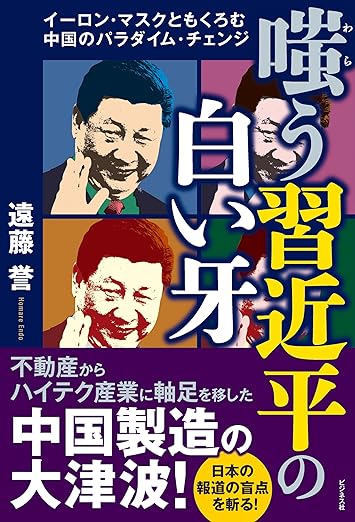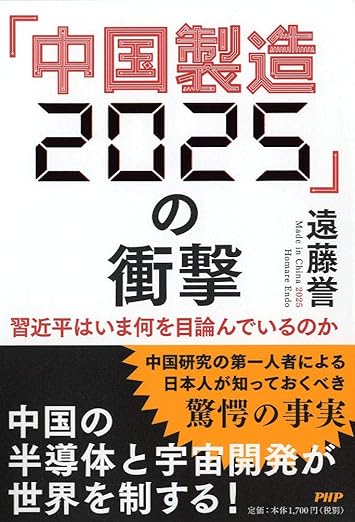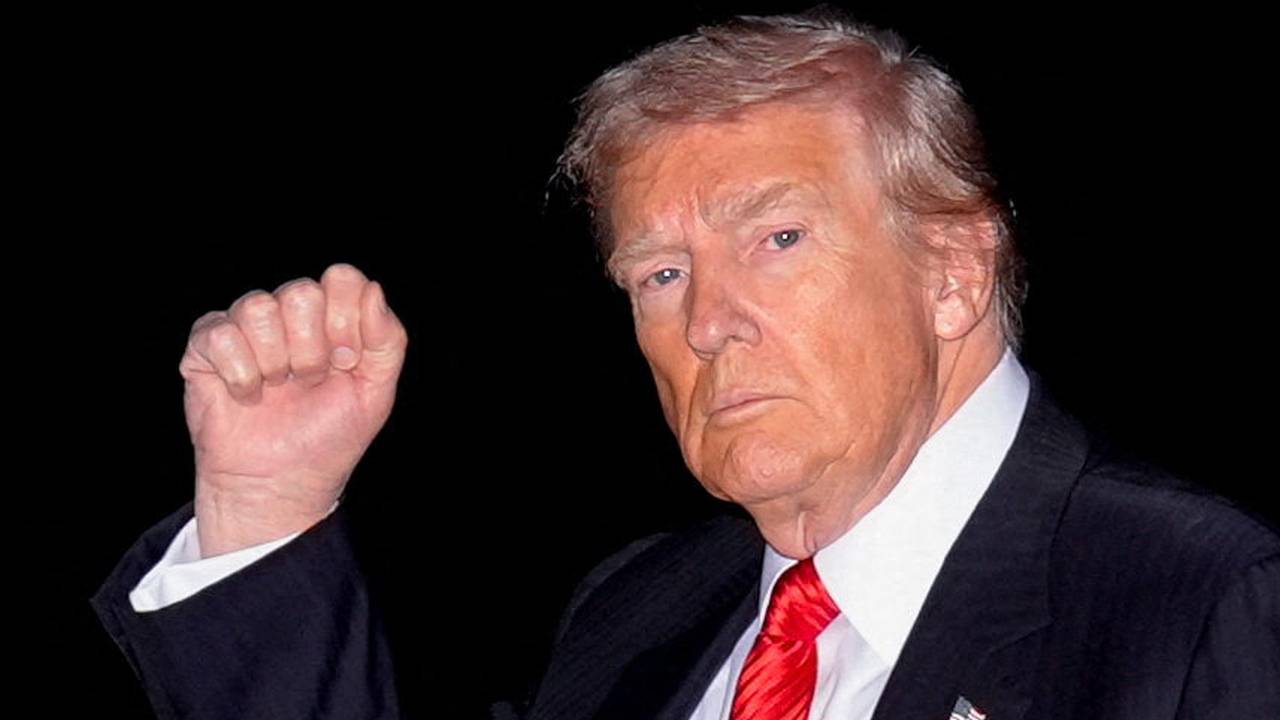
President Trump posted the term “G2” in reference to the U.S. and China on Truth Social before and after his meeting with President Xi Jinping in South Korea on October 30. On October 31 (U.S. Eastern Time), Trump participated in a roughly hour-long interview for the U.S. broadcaster CBS. In the interview, he stated, “I think we [the U.S.] can be bigger, better, and stronger by working with them [China] as opposed to just knocking them out.” The White House later issued a shortened version of the interview, which I would like to introduce here.
The U.S.-China rivalry will have to be settled at some point. There are concerns that eventually, China may surpass the U.S., and war could break out at that time. If a leader were to emerge who could achieve the near-impossible feat of handling that moment peacefully, while keeping the U.S. strong and enabling both nations to coexist, it would be nothing short of a miracle for humankind. Although Mr. Trump’s policies have their share of problems, nobody but Donald Trump can take this approach and directly address the U.S.-China rivalry with it.
At 4:27 p.m. on October 30 (U.S. Eastern Time), the White House released exclusive photos in its possession. The photos show the inside scene during the U.S.-China summit. One photo shows Xi Jinping bursting into laughter, with all members of the Chinese delegation also smiling or laughing. In this article, I would like to present 4 of the 42 photos released.
On November 1, President Xi Jinping met with South Korean President Lee Jae Myung. During the meeting, Xi made a lighthearted joke at his expense and laughed alongside President Lee, who burst into hearty laughter.
Meanwhile, Japanese Prime Minister Sanae Takaichi met with former Taiwanese Vice Premier Lin Hsin-i before and after her meeting with Xi Jinping. After the meeting, she posted a photo of the two of them on X, prompting a strong protest from China’s Ministry of Foreign Affairs.
The approaches taken by Japan, the U.S., and South Korea toward China were not necessarily coordinated. While the U.S. and South Korea have begun engaging in “smile diplomacy” with China, Japan’s diplomacy toward China may be overshadowed by hidden difficulties ahead.
◆ Trump Lifts Xi Jinping by Announcing the “G2” Era for the U.S. and China
The U.S.-China summit between Trump and Xi Jinping began at 11:13 a.m. on October 30. Earlier that day, at 10:08 a.m., Trump posted the following on his own social media platform, Truth Social: “THE G2 WILL BE CONVENING SHORTLY!”
After finishing the U.S.-China summit and returning to the U.S., Trump posted to Truth Social at 5:11 a.m. on November 2 (Japan Standard Time), mentioning the G2 again. He wrote: “My G2 meeting with President Xi of China was a great one for both of our countries. This meeting will lead to everlasting peace and success. God bless both China and the USA!”
When Xi Jinping was still Vice President of China, he was interviewed by the Washington Post on February 13, 2012, and noted that “The vast Pacific Ocean has enough space for two large countries like the United States and China.” He repeated this statement several times thereafter. For example, he used the same words in a meeting with President Obama when he visited China on November 12, 2014. This effectively signified a G2 relationship, referred to in Chinese as a “new type of major-power relationship.” However, the Obama administration responded somewhat cynically, and Xi Jinping subsequently did not use this phrase again.
Yet this time, the term “G2” came from the U.S. side. This can be viewed as a truly epoch-making development, and one that could only have happened because of Trump.
Former President Biden would have never said such a thing. He constantly called on allies and friendly nations to contain China and was intent on crushing the country. Japan’s spirit may still be under the influence of the Biden administration.
◆ Trump: The U.S. Can Be Stronger by Working with China as Opposed to Just Knocking Them Out
In the afternoon of November 2, CBS News published the full transcript of its roughly 60-minute interview with President Trump under the heading, “Read the full transcript of Norah O’Donnell’s interview with President Trump here.”
The following day, on November 3, the White House released a summarized version of the interview under the heading “President Trump on 60 Minutes: ‘Greatest Nine Months in the History of the Presidency.’” The section titled “On China” reads as follows:
——“It’s like everybody else. We’re a threat to them, too… This is a very competitive world, especially when it comes to China and the U.S. We’re always watching them and they’re always watching us. In the meantime, I think we get along very well, and I think we can be bigger, better, and stronger by working with them as opposed to just knocking them out.” (End of excerpt from the White House)
Has there ever been a U.S. president who could make such a statement? Its significance is as noted at the beginning of this article.
◆ Xi Jinping Bursts Into Laughter with Trump and His Delegation
The White House released a total of 42 photos from the U.S.-China summit held on October 30, including several taken during the private meeting that were not open to the press. Of these, I’ve selected 4 (numbers 29 through 32 in the sequence of photos), which are shown in Exhibits 1 through 4.
Exhibit 1: Trump shows a postcard-sized memo as if to say, “Take a look at this!”

Reprinted from the White House website
It is not clear what is written or drawn on the memo, but at this point all members of the Chinese delegation already appear amused.
Exhibit 2: Trump thrusts the memo forward, as if to say, “Here, look at this,” and Xi Jinping smiles.
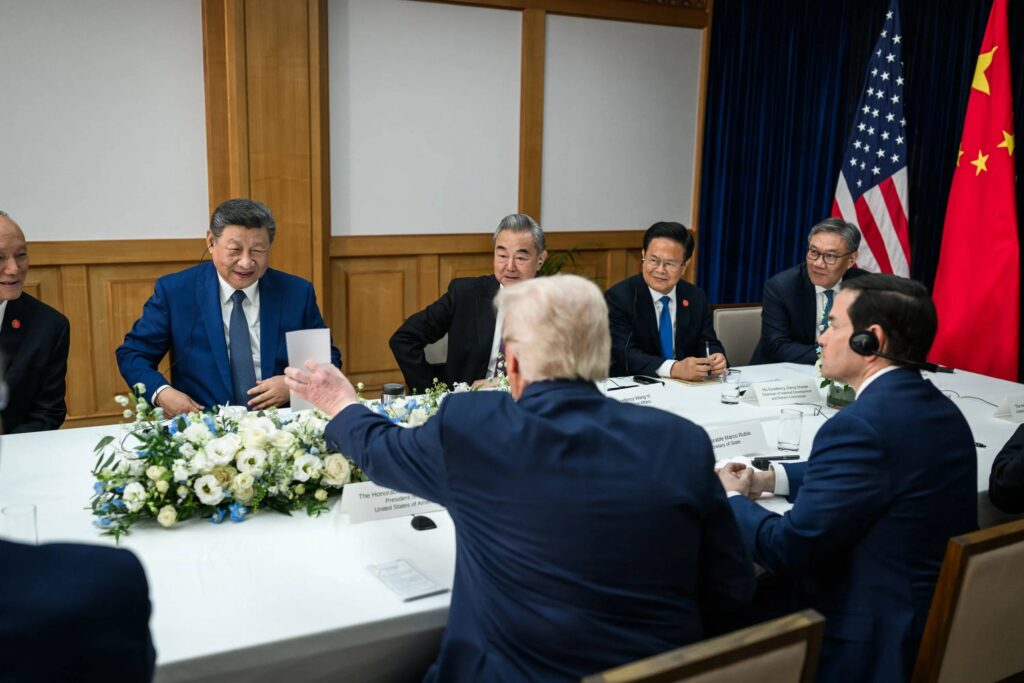
Reprinted from the White House website
In Exhibit 2, Xi Jinping smiles happily as he looks intently at the memo. Trump seems to be explaining something.
Exhibit 3: Xi Jinping reaches for the memo, as if to say, “Let me see!”
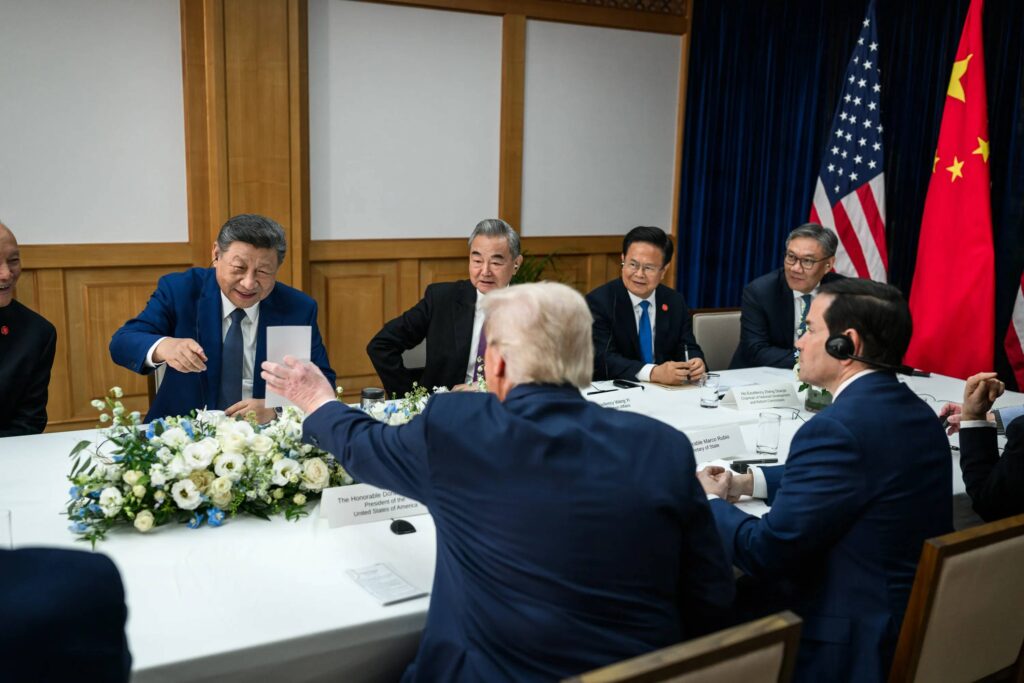
Reprinted from the White House website
Since this is just a photo, it is not clear what is written or what is being said. However, Xi Jinping seems to be reaching out, as if saying, “What’s this? Let me see!” The other Chinese delegates look curious and amused.
Exhibit 4: Xi Jinping bursts into laughter! Everyone laughs heartily!
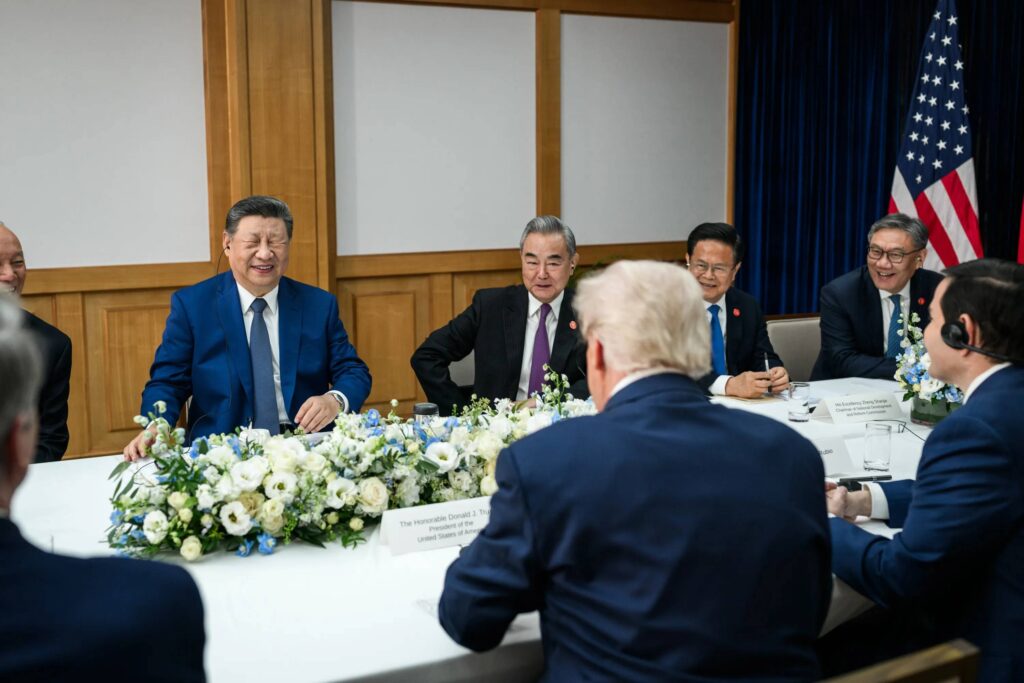
Reprinted from the White House website
In Exhibit 4, it looks like Xi Jinping can’t help but laugh heartily, his eyes squeezed shut from laughing so much.
I wonder what was shown. I’m eager to know, but no information is available at this time.
In any case, I don’t think such a cordial U.S.-China summit has ever taken place since the normalization of diplomatic relations between the U.S. and China. It can be said to be a historic first, made possible precisely because Donald Trump is the U.S. president.
For reference, I’d like to introduce a roughly 20 second video released by the White House that provides a glimpse into how Trump positions this summit.
◆ President Xi Jinping and President Lee Jae Myung Share a Light Moment of Laughter with a Self-deprecating Joke
On November 1, Xi Jinping presented two mobile phones as gifts to South Korean President Lee Jae Myung during their meeting. When the two leaders displayed the gifts before the press cameras, the Chinese interpreter explained, “These mobile phones are made by the Chinese company Xiaomi and are equipped with Korean-made displays.”
Lee Jae Myung picked up one of the unopened mobile phones, and while examining the box, asked, “How secure are these phones?” Xi Jinping responded with a smile, “You can check whether there’s a backdoor.” Hearing this, Lee Jae Myung clapped his hands together in a gesture of applause and burst into hearty laughter, prompting Xi to laugh along good-naturedly. The scene was captured by the cameras. For example, the title image on The New York Times Chinese website shows the moment pictured in Exhibit 5. A video of the same scene can also be found on Shanghai Media Group’s ShanghaiEye channel.
Exhibit 5: Chinese and South Korean leaders burst into laughter at the “backdoor” joke cracked by Xi Jinping.
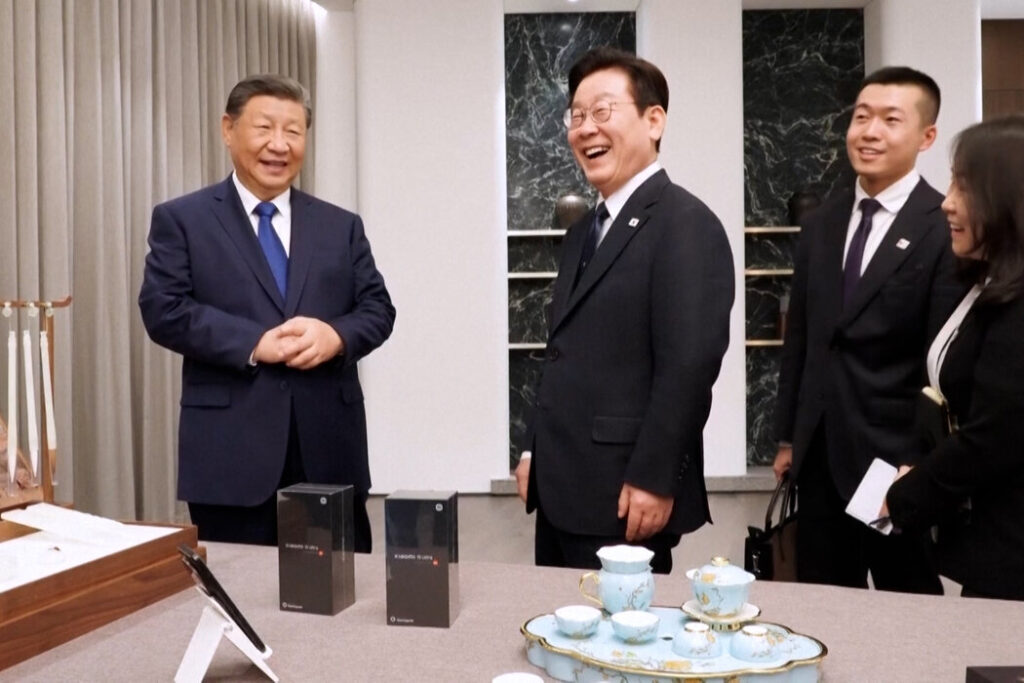
Reprinted from The New York Times Chinese website
It’s almost unheard of for Xi Jinping to make a spontaneous, lighthearted joke at his expense like “You can check whether there’s a backdoor.” I imagine that the wave of lighthearted humor strategically initiated by Trump may have even extended to Xi’s relationship with the South Korean president.
However, Japan alone was left behind in that wave. After the Japan-China summit, Prime Minister Takaichi took actions that rubbed Xi Jinping the wrong way.
◆ China’s Ministry of Foreign Affairs Furious: Prime Minister Takaichi Posts Photo with Taiwan’s Representative on X
Just before 10:00 a.m. on October 31, prior to officially meeting Xi Jinping, Prime Minister Takaichi greeted many leaders waiting in the holding room at the APEC Economic Leaders’ Meeting in South Korea. Among them were Xi Jinping and Taiwan’s representative, former Vice Premier Lin Hsin-i.
The photo of Prime Minister Takaichi greeting Xi Jinping was posted on X at 3:15 p.m. on October 31, while the photo with Taiwan’s Lin Hsin-i was posted on X later, at 8:01 p.m., after the meeting with Xi. In that post, Lin Hsin-i’s title appears in Chinese as “総統府資政,” which translates to “Senior Advisor to the President.” The term “資政” means “Senior Advisor,” indicating that the X post used the honorific for a Senior Advisor to the President currently serving in office.
Xi Jinping was unaware of this during his summit with Sanae Takaichi. Even this alone is enough to cause some embarrassment to Xi Jinping.
Moreover, on November 1 at 6:26 p.m., after the APEC Economic Leaders’ Meeting ended, Sanae Takaichi posted another photo with Taiwan’s Lin Hsin-i on X, announcing that she had met with him.
At this point, the Chinese side had had enough. The Chinese Ministry of Foreign Affairs issued a strong protest against Sanae Takaichi’s X posts, stating that “hyped it on social media, severely violated the one-China principle!”
Incidentally, former Japanese Prime Minister Shigeru Ishiba also exchanged greetings with Lin at the APEC Economic Leaders’ Meeting one year ago, but he did not post anything on X, so China did not lodge a protest. It can be assumed that China considers it normal for leaders to at least exchange greetings if they encounter one another in the holding room.
On November 4, Foreign Minister Toshimitsu Motegi stated, “There is no change in the Japanese government’s position,” as reported in the article “No change in government position: Rebuttal to China over Prime Minister Takaichi’s Meeting with Taiwan’s Representative.” However, Mr. Motegi may have missed a key point.
Please take a close look at Exhibit 6, which lists the following items for successive Japanese prime ministers over roughly the past ten years at APEC Economic Leaders’ Meetings: any meetings with Taiwan’s representative, posts on X (Twitter) and the like, and protests from China.
Exhibit 6: Meetings Between Representatives of Japan and Taiwan at APEC Economic Leaders’ Meetings and Protests from China

Prepared by the author based on Taiwan’s official announcements and media reports over the years, posts on each prime minister’s X (Twitter) account, and information from the website of the Chinese Ministry of Foreign Affairs
Exhibit 6 makes everything clear.
Successive Japanese prime ministers have met with Taiwan’s representative at APEC, but none have ever posted about it online on X (formerly Twitter) or other social media platforms. This reflected a degree of restraint.
However, Prime Minister Takaichi was the only one not to show that restraint. She crossed the “red line” that the prime ministers before her had consistently respected.
Moreover, as I wrote in my November 1 article, “Japan-China Summit Finally Realized: Xi Jinping’s Intent in Keeping Japan Waiting Until the Last Minute,” China was already angered by Komeito’s withdrawal from the ruling coalition, and Xi Jinping did not send a congratulatory message to Prime Minister Sanae Takaichi upon on her appointment. This, too, marks the first time Beijing has deviated from the usual practice.
Even so, since the Japanese side eagerly wanted China to participate in a Japan-China summit, Xi Jinping probably considered it a major concession on his part to agree to hold the meeting.
In response to Xi Jinping, Prime Minister Takaichi did what no previous Japanese prime minister had ever done. She posted about it online.
Doesn’t Foreign Minister Motegi recognize what makes this different? For someone of his experience, this is disappointing. His understanding is far too shallow. I have to say that, as foreign minister, he has failed when it comes to relations with China. With such a shallow grasp of the situation, he cannot possibly protect Prime Minister Takaichi.
On October 23, I wrote an article titled “President Trump’s Stance Toward China (Affection for Xi Jinping?) That I Want Prime Minister Takaichi to Understand Before the Japan-China Summit” to urge caution. As the author, I wrote it out of goodwill, hoping that those around Prime Minister Takaichi would take note and be able to protect her. Unfortunately, I later found that my warning had gone unheeded.
It is good to be firm. However, it is not desirable to cross the red lines that successive prime ministers have respected with restraint to protect Japan, or to disrupt the coordination among Japan, the U.S., and South Korea. I believe that it might have been beneficial to demonstrate a certain degree of wisdom or seasoned shrewdness in this situation. That said, I would like to conclude by saying that I still have high hopes and expectations for Prime Minister Takaichi.
Postscript: As I wrote in my article titled “U.S.-China Summit: As Expected, the Hurdle Was the Change in the 50% Rule!,” Trump told the media that the Taiwan issue was not raised on the agenda at the U.S-China summit.
This article is translated from 《トランプが「中国を倒すのではなく協力することでアメリカは強くなる」と発言!これで戦争が避けられる!》。
カテゴリー
最近の投稿
- 台湾有事で米軍の援軍はあり得るか? トランプ2.0とバイデン政権の対台湾武器提供の比較から
- Europe’s China Problem
- 日本の戦略的転換と、インド太平洋抑止に台湾が果たす新たな重要性
- トランプ氏の習近平・高市両氏への電話目的は「対中ビジネス」 高市政権は未だバイデン政権の対中戦略の中
- 中国の「高市非難風刺画」は「吉田茂・岸信介」非難風刺画と同じ――そこから見える中国の本気度
- 中国の高圧的な日本叩きに対して日本が持っているカード
- 高市発言に習近平はなぜここまで激怒するのか? 日本は台湾問題を口実にせず防衛力に戦略を
- Japan’s Strategic Turn and Taiwan’s New Centrality in Indo-Pacific Deterrence
- 中国の第15次5カ年計画の建議に見る政治経済の転換:成長のナラティブから安全保障を基軸とした統治へ
- Trump Proclaims the U.S. Can Be Stronger by Working with China as Opposed to Just Knocking Them Out — War Could Be Avoidable!




